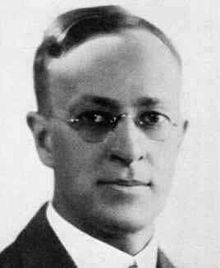Gilbert Ames Bliss
Gilbert Ames Bliss (born May 9, 1876 in Chicago , † May 8, 1951 in Harvey , Illinois ) was an American mathematician who mainly worked on the calculus of variations .
Live and act
Bliss studied astronomy and mathematics at the University of Chicago (founded two years earlier) from 1893 , whereby he had to finance his studies himself (the family did not become wealthy until his father became director of the Chicago electricity company). B. by playing in a mandolin quartet. In 1897 he completed his bachelor's degree, but did not turn to mathematics until 1898, influenced by reading Karl Weierstrass's lectures on calculus of variations from 1879. In 1900 he received his doctorate from Oskar Bolza (Geodesic lines on the anchor ring, Annals of Mathematics 1902), who was also a specialist in calculus of variations and author of a well-known textbook on the subject. He then was an instructor at the University of Minnesota . In 1902/03 he attended the University of Göttingen, where he studied with Felix Klein , Hermann Minkowski , David Hilbert , Ernst Zermelo , Constantin Caratheodory and Erhard Schmidt , among others . He then went to the University of Chicago, the University of Missouri and, from 1905, at Princeton University , where Luther Pfahler Eisenhart , Oswald Veblen and Robert Lee Moore were at that time. In 1908 he succeeded Heinrich Maschke as professor in Chicago, where he stayed until his retirement in 1941 and was chairman of the mathematics faculty from 1927 (as the successor to Eliakim Hastings Moore ).
His classic textbook on the calculus of variations, published in 1946, summarizes the older developments, enriched by his own results, when the area was already undergoing a significant reorientation by Marston Morse and others. During the First World War he worked with Veblen as a ballistician on the Aberdeen Proving Ground of the US Army and applied methods of the calculus of variations there, published in a book in 1944.
He was married twice (his first wife died in the flu epidemic after World War I) and had two children from his first marriage.
In 1916 he became a member of the National Academy of Sciences , in 1926 of the American Philosophical Society and in 1935 of the American Academy of Arts and Sciences . In 1911 he was Vice President and 1921/22 President of the American Mathematical Society , whose Colloquium Lecturer he was in 1909. In 1925 he received the first Chauvenet Prize .
Fonts
- Algebraic Functions. 1933.
- Mathematics of Exterior Ballistics. 1944.
- Lectures on the calculus of variations. 1946.
Web links
- Literature by and about Gilbert Ames Bliss in the catalog of the German National Library
- John J. O'Connor, Edmund F. Robertson : Gilbert Ames Bliss. In: MacTutor History of Mathematics archive .
- Gilbert Ames Bliss in the Mathematics Genealogy Project (English)
| personal data | |
|---|---|
| SURNAME | Bliss, Gilbert Ames |
| BRIEF DESCRIPTION | American mathematician |
| DATE OF BIRTH | May 9, 1876 |
| PLACE OF BIRTH | Chicago |
| DATE OF DEATH | May 8, 1951 |
| Place of death | Harvey , Illinois |
